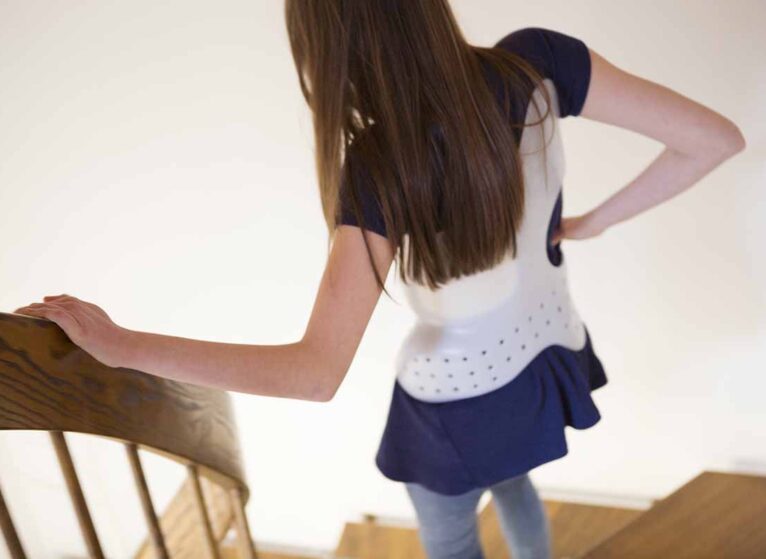Everyone’s spine curves some. But with scoliosis, the curve is too great or in the wrong direction (forming either an S or C). For some kids with scoliosis, the best option is to wait and watch. But if the curve starts to get worse, bracing or surgery may become necessary.
Severe scoliosis can cause pain. The spine can also crowd the heart and lungs, causing more serious issues. For severe scoliosis, surgery is often the only option. Most surgical options work by connecting portions of the spine. While this is effective, it limits range of motion.
For moderate scoliosis, bracing is a great alternative.
Bracing can’t get rid of the curve. But it can keep it from getting worse. By holding the curve steady while your child finishes growing, it’s possible to avoid surgery. Bracing only works for kids who are still growing. 4 out of 5 kids who use a brace will avoid surgery.
Kids & Braces
Many kids are hesitant to try scoliosis bracing. This can happen for a few reasons, but some of the biggest are:
- Ease of movement
- Not being able to participate in their favorite activities
- Feeling excluded socially
- Bruising and blistering
- Getting overheated
Most of these reasons boil down to one. Comfort. When braces aren’t comfortable, kids don’t want to wear them. And when they aren’t worn, braces can’t work.
I asked scoliosis expert Keith Bachmann, MD, about what he says to his patients and their families as they begin bracing.
“While we will provide guidelines for bracing, it is important to take control and make bracing their own. More time spent in the brace IS better. But bracing is not guaranteed to work, so parents and patients should give themselves grace regarding their use of the brace,” Bachmann says.
Here are ways that you can help your child take control and make bracing their own.
Worried About Your Child's Scoliosis?
Schedule an appointment at UVA Health Children's and find out what treatment option is right for your family.
Help Them Learn Their Brace
No two scoliosis braces are the same. Each is carefully made to help correct the spinal curve of the child it’s made for. Even though your child’s brace will have marks made in the straps, Bachmann emphasizes that comfort should come first. “If we know the brace is pushing in the right spot, then time in the brace matters more than correction, so whatever it takes to maximize the time in the brace,” he says.
Many kids also said they had an easier time with their brace once they learned how to take it on and off themselves. This is a skill that only comes with practice. So, schedule an afternoon to help them try different methods.
Mind The Scoliosis Brace Break-In Period
Just like shoes, scoliosis braces that haven’t been broken in can cause bruises and blisters. Your child’s doctor will recommend a “breaking-in” schedule.
During the “breaking-in” time, your child will wear their brace for gradually increasing periods of time. That way they’re not going from no brace to wearing one for almost an entire day. This helps your child get used to the brace, but it also helps the brace get broken in without creating pain points.
For most people, this weaning period lasts between 1 and 2 weeks.
If your child does get bruises or blisters, you should contact their doctor. “We would want to know about bruises and blisters to provide guidance about decreasing the tension of the straps on the brace or time in the brace,” Bachmann adds.
Manage The Heat
One of the most frequent complaints about scoliosis braces is that heat builds up inside. For kids, especially those who love playing outside in the sun, this can be a real problem.
For a long-term solution, talk to your child’s orthotist (the specialist who makes sure the brace fits correctly). They can add airholes that can keep heat from building up inside. But resist the urge to drill in yourself. “The orthotist can make adjustments without altering the areas of ‘push,’” Bachmann says.
Some other ways to help your child can include:
- Add an extra fan to their bedroom
- Take a brace-break for the hottest or most active part of the day
- Take frequent hydration breaks while playing
- Enjoy cold treats, like popsicles, on summer days
- Get moisture-wicking undershirts
- Carry rubbing alcohol to deal with a sweaty brace
Address Skincare Concerns
It’s normal for kids to develop skin issues, like heat rash, under their scoliosis brace. There are a lot of different solutions for heat rash, so talk with your child about what works for them. Pure aloe vera can be great, but many kids don’t like the way it feels. A lanolin-based moisturizer can help prevent heat rash while also leaving sweat ducts unclogged.
If your child does develop heat rash, mixing a small amount of hydrocortisone cream with their lotion of choice can help reduce the itch.
Find Brace-Friendly Clothing Options That Work
Many kids feel self-conscious about their brace, and this can make clothing challenging. Changing clothing trends don’t usually consider your child’s need for a brace. Fortunately, there are plenty of ways to work with a brace and clothing.
An undershirt underneath a brace can keep it from rubbing. They can wear another shirt on top over the brace. Make sure the undershirt is longer than the brace.
Take your child clothes shopping with their brace on. That way, they can try on a variety of styles to see what works best.
Many schools allow for dress code changes for a medical issue. Talk to your kid’s school about creating a plan.
Help Them Enjoy Brace-Free Time
For many, bracing will be recommended for most of the day. But everyone should take, and enjoy, time away from their scoliosis brace.
Dance lessons, swim meets, and other activities are great times to take off the brace. This may be surprising, as many parents are used to braces for injuries.
But with scoliosis, it’s about time in the brace. And that time doesn’t have to be in a block. Taking the brace off for gym class or fun afterschool clubs can help kids stay active and may make it easier to wear the brace during other times.
The important thing is finding an activity that makes the most out of the time that’s brace-free.
Schedule Frequent Check-Ins
For many kids, the thing that made the most difference with scoliosis brace wearing was having someone who listened and could help them problem-solve and self-advocate. Even when concerns seem minor (like being unfashionable), for kids, these things can be a big deal. Knowing they’re heard and that you’re willing to work with them can be the key to making bracing a success.
Talk about issues with brace wearing. Acknowledge that it’s difficult. And when brainstorming as a family doesn’t come up with answers, talk to your medical team. A simple change may make bracing a little easier.


My daughter is using the corset since a year, in the begging she didn’t used it on the day time only nights but them she started to used all day but the question is . How often the orthopedic needs to check the brace ? To see if needs to adjusted ?
Hi Julia! According to Dr. Bachmann, her orthopedist should be checking in every 6 months. But if she’s experiencing discomfort, a growth spurt, or something else has changed, then you should call and let them know. I hope that helps!